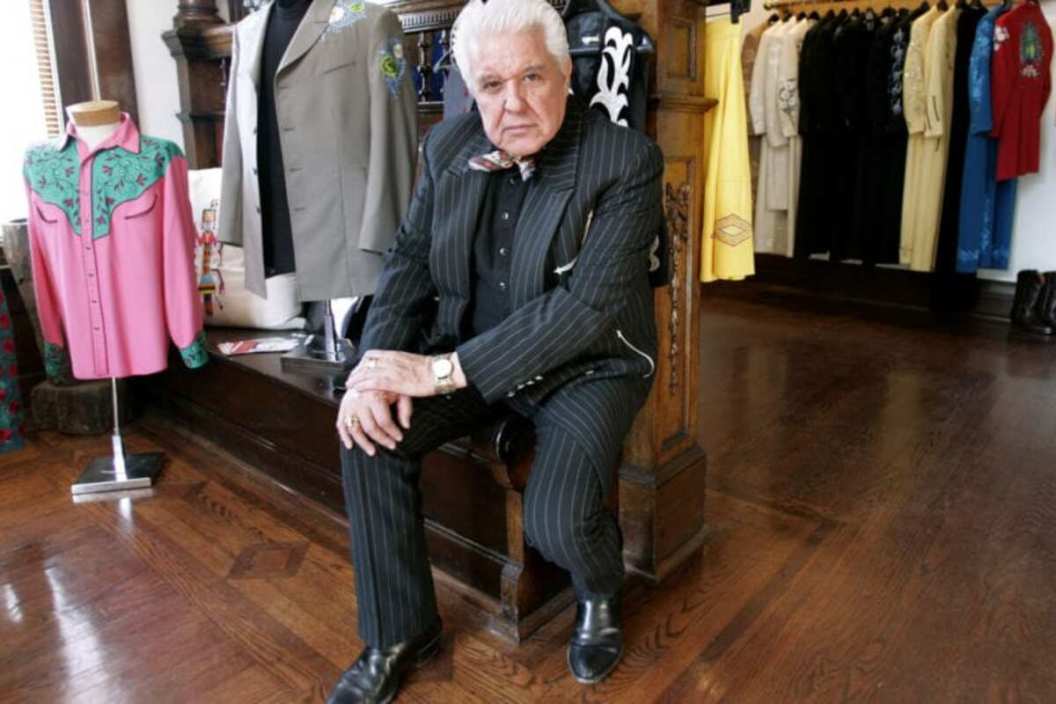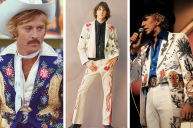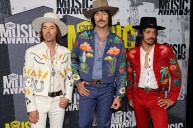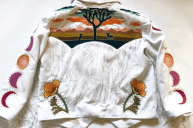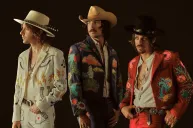[dropcap]F[/dropcap]or over 50 years, entertainers have flocked to Manuel Cuevas to create their clothing. From Elvis' signature gold suit to Dwight Yoakam's famous rhinestone embedded bolero jacket that graced the cover of his 1987 album Hillbilly Deluxe, Manuel outfits stars with perfect tailoring and a whole lot of sparkle. His showstopping designs have earned him the title of the "Rhinestone Rembrandt," but to friends, celebrities, music icons and world dignitaries, he's known by just one name: Manuel.
Videos by Wide Open Country
The Man Behind Nudie
Manuel was born in Mexico in the central-western town of Coalcomán. He started sewing at the age of seven.
He says making clothes was his destiny.
"I guess it was mainly a calling," Manuel tells Wide Open Country. "I sat down at the sewing machine and I never got up."
At the age of 12, Manuel started making prom dresses for the neighborhood girls. Even then, he saw the need for original style.
"I was looking at all the prom dresses and 'sweet sixteen' (dresses) and all theses things over there in Mexico," Manuel says. "I thought 'why do they all look alike? I can change that.' So I got into making gowns for the girls, charging a small fortune for it. They all loved them, and they all liked me, and they made me as rich as I could be."
After making all the prom dresses he could handle, Manuel set out to Los Angeles, Calif. and quickly fell in with heavy hitters in the fashion industry who recognized his raw talent. One such fashion maven was famed Hollywood costume designer Edith Head. Through his friendship with Head, Manuel created wardrobes for over 90 movies and 13 television shows, creating everything from James Dean's jeans in "Giant" to the Lone Ranger's iconic mask.
"I was introduced to a lot of personalities and a lot of stars as you might call them, but to me they were just actors and people trying to make a living," Manuel says.
He spent his early years in Hollywood working for Sy Devore, a well-known Los Angeles tailor who made suits for the Rat Pack. But tailoring suit after suit didn't interest Manuel, even if they were for Frank Sinatra. He wanted the flash and razzle dazzle of stage wear--something that would stop folks in their tracks.
Enter Nudie Cohn, the free-wheeling owner of Nudie's Rodeo Tailors in Northern Hollywood. Nudie, who followed in the footsteps of western wear makers like Nathan Turk and Rodeo Ben, recognized Manuel's skill and quickly hired him to work in his shop. Many of the famous "Nudie suits," the flamboyant, rhinestone adorned, intricately embroidered outfits that were the hallmark of 1950s and 60s country fashion, were designed and created by Manuel.
In his 14 years at Nudie's Rodeo Tailors, Manuel became head designer and eventually partner of the business. He married Nudie's daughter, Barbara, and had a daughter, Moriela.
He had a client list most designers would kill for. He dressed Hank Williams, Roy Rogers, Gene Autry, Johnny Cash, Porter Wagoner, country-rock pioneer Gram Parsons and hundreds in between. But for all his success, the designer says he's always valued his friendships with the clients and the art of his unique creations above all else.
"I was not too much for fame, and I was not too much for money," Manuel says. "I fell in love with the clothes."
In 1975, after Barbara and Manuel divorced, Manuel left Nudie's Rodeo Tailors and opened Manuel Couture just down the street. It wasn't long before country came calling again.
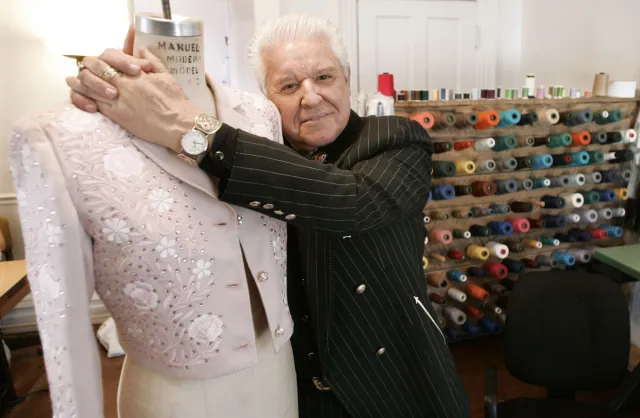
Manuel Arturo Jose Cuevas Martinez, known simply as Manuel, is shown with an outfit being made for country music performer Lorrie Morgan in his clothing studio in Nashville, Tenn., Wednesday, Dec. 15, 2004. Manuel's flashy, western-styled clothes are popular with country and rock musicians alike, as well as with the fashion-minded private sector. (AP Photo/Mark Humphrey)
Dressing the Apostles
Many of Manuel's country clients followed him to Manuel Couture. His kinship with the country music community only grew in the following decade. Young traditionalists such as Marty Stuart and Dwight Yoakam wanted their own spin on the Manuel-made creations like their heroes had worn.
Country artists love Manuel and he loves them right back.
"I know that the Marty Stuarts, the Dwight Yoakams, George Jones, Johnny Cash -- all these beautiful people, those are the apostles of music," Manuel says. "I just love them. I love the history."
One apostle of music, Johnny Cash, was one of Manuel's closest friends.
"We knew each other not as artist and designer but as friends and that's what I really enjoyed," Manuel says. "He knew how to part the waters of the river. We would get quiet when he walked into a room. We had that much respect."
In 1956, Cash requested that Manuel create a wardrobe for his upcoming tour. Inspired by Cash's commanding presence and often somber on-stage demeanor, Manuel chose one defining color for the suits.
"(Cash) said 'You made me nine outfits and they're all black, what's this?' I said 'Well, brother, there was a sale on black fabric.' Of course I was kidding him."
Cash loved the clothes. When ordering another round of suits, the newly-minted Man in Black told Manuel "the color is no longer in question."
The Most Famous Suit in the World
Out of all of Manuel's famous designs, there's still one that stands out above the rest--at least in the eyes of the public.
Worn by Gram Parsons on the cover of the Flying Burrito Brothers' 1969 album The Gilded Palace of Sin, the white suit adorned with marijuana leaves, poppies, prescription pills and a giant cross has long captivated music fans worldwide. Though it's referred to as a Nudie suit, the design was all Manuel. And given the response he still gets regarding garment, Manuel suspects it may be the most famous suit in the world.
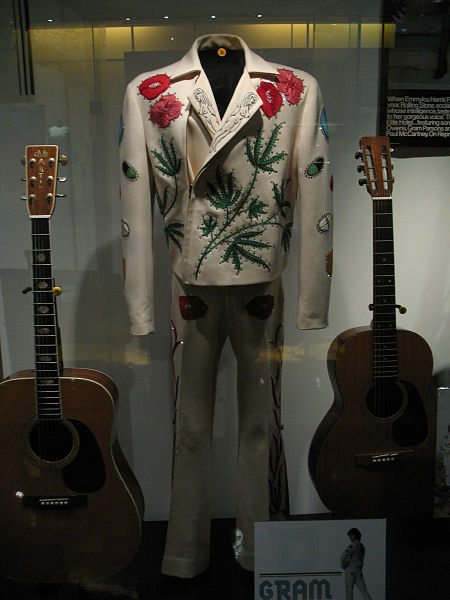
Source: Wikipedia Commons
"Everywhere I go (it's) 'Oh my God, Gram Parsons! Gram Parsons!' They don't even know the trash I went through after I made that outfit for him. The protesters, everybody was like 'how do you dare to put marijuana plants or whatever (on the suit)," Manuel says. "(Gram) was a little ahead of his time and so was I. He was a young man. I was the old man."
Still One-of-a-Kind
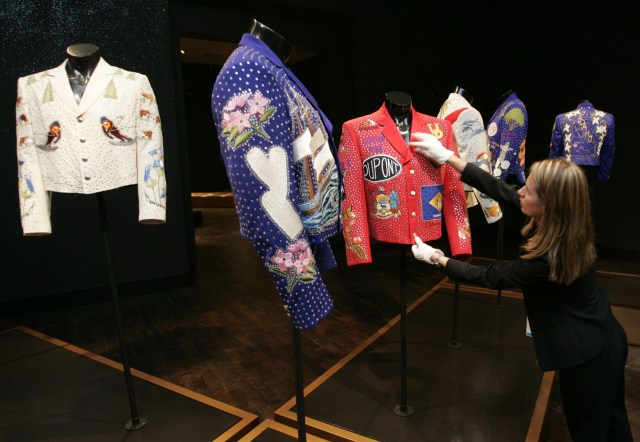
Katie Welborn, associate curator at the Frist Center for the Visual Arts in Nashville, Tenn., adjusts a display of jackets created by Manuel Arturo Jose Cuevas Martinez, known simply as Manuel, in Nashville, Tenn., Wednesday, Dec. 15, 2004. Manuel's flashy, western-styled clothes are popular with country and rock musicians alike, as well as with the fashion-minded private sector. An exhibit of his work opens Friday, Dec. 17, in Nashville. (AP Photo/Mark Humphrey)
At 86, Manuel is still going strong. Now operating out of his shop in downtown Nashville, the fiercely original designer still rejects mass production and refuses to make the same garment twice.
"Only one-of-a-kind," Manuel says. "People say 'Will you make me something like you did for Robert Redford.' I say 'Are you kidding me? Find another person to do a copy of that. I don't do those things'."
Today, getting a custom piece from Manuel is still the dream for any Nashville newcomer. For Manuel, making clothing is still about connecting to the person inside the suit, whether it's the Man in Black or the next rising star.
"More than anything else, I just want to be part of them."
This article was originally published in 2017.
